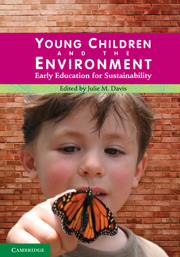Book contents
- Frontmatter
- Foreword
- Contents
- List of contributors
- Introduction
- PART 1
- Chapter 1 What is early childhood education for sustainability?
- Chapter 2 Children in the natural world
- Chapter 3 Leadership for creating cultures of sustainability
- Chapter 4 Practical possibilities and pedagogical approaches for early childhood education for sustainability
- Chapter 5 Ethics and pedagogy at the heart of early childhood education for sustainability
- PART 2
- Endnote
- Index
- References
Chapter 2 - Children in the natural world
from PART 1
- Frontmatter
- Foreword
- Contents
- List of contributors
- Introduction
- PART 1
- Chapter 1 What is early childhood education for sustainability?
- Chapter 2 Children in the natural world
- Chapter 3 Leadership for creating cultures of sustainability
- Chapter 4 Practical possibilities and pedagogical approaches for early childhood education for sustainability
- Chapter 5 Ethics and pedagogy at the heart of early childhood education for sustainability
- PART 2
- Endnote
- Index
- References
Summary
EDITOR'S NOTE
In this chapter, Sue Elliott makes the case for deep, authentic experiences in nature as foundational for young children's holistic and healthy growth and development. She emphasises that play in nature is fundamental to young children's learning. Sue argues that early childhood education has a long history that supports play in natural playspaces that must not be eroded.
Equally importantly, she argues that play in nature is not sufficient as a form of early childhood education for sustainability. Sue asks readers to contemplate their own relationships with nature and the outdoors while provoking them to deepen and widen their ideas and practices. She argues that early childhood educators have an important role in embedding nature into children's play environments and in sharing with children their enthusiasm and wonder about the natural world.
STORIES FROM THE FIELD
When visiting an early childhood centre during morning snack time, I asked the obvious question of a child munching on an apple: ‘Where do you think apples come from?’ The child replied promptly, ‘The supermarket’. I then asked, ‘Well, I wonder where the supermarket gets apples from?’ She replied [demonstrating with her hands] ‘Oh, they just get some yellow stuff and squash it all together, then they put more stuff on the outside’.
Early childhood educators are highly familiar with the somewhat amusing perspectives children express about how the world works. But, should we view this anecdote as a source of amusement or a source of alarm? How disconnected from nature have children become when an everyday food item such as an apple is perceived as a manufactured product? […]
- Type
- Chapter
- Information
- Young Children and the EnvironmentEarly Education for Sustainability, pp. 43 - 75Publisher: Cambridge University PressPrint publication year: 2010
References
- 18
- Cited by



